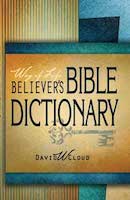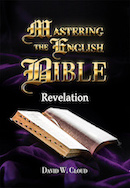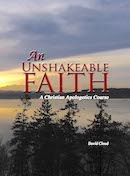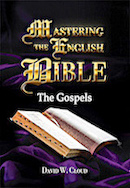866-295-4143, fbns@wayoflife.org
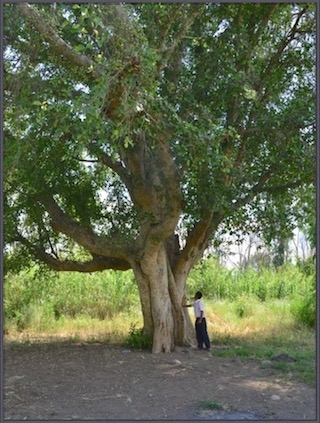
In Joshua’s day, the hills in Israel’s heartland (the tribes of Ephraim and Manasseh) were called “the wood country” because of the forests (Joshua 17:15, 18).
Absalom was killed in the forest of Ephraim (2 Sa. 18:6, 8). Apparently it was an oak forest, because his head was caught in the branches of a “great oak” (2 Sa. 18:9).
In David’s day, there was a grove of mulberry trees in the valley of Raphaim, which was a couple of miles to the southwest of Jerusalem (2 Sa. 5:23-24). This is the Hebrew baka, which means weeping. Mulberry fruit is mentioned in the 1st book of the Maccabees (1 Macc. 6:34). This is the Morus nigra tree, which has black berries. It is probably the same as the sycamine Jesus mentioned in Luke 17:6. “In Israel mulberry tree remains have been found from the late Iron Age. In modern Israel, mulberry trees grow wild and are domesticated from Mount Hermon in northern Israel to Eilat in the southern Negev Desert. During our stay at Kibbutz Lotan in the southern Negev Desert area in 2012, we saw a 25 foot tall mulberry tree which had been planted for its shade as well as its fruit” (“Moving a Mulberry Tree,” God as a Gardener, Sep. 18, 2013).
The Gibeonites were made hewers of wood for the tribes of Israel, which would indicate that there were plenty of trees (Joshua 9:21, 23, 27).
There was a forest east of Bethel in Bethaven (1 Sa. 14:25).
There was a forest in the wilderness of Ziph, southeast of Hebron and a few miles west of the Dead Sea (1 Sa. 23:15, 19), and there was a forest in Hareth (1 Sa. 22:5), which was south of Ziph toward the southern end of the Dead Sea. These places are in the Judean wilderness and the Negev, which has long been barren desert except for the areas developed by the state of Israel since the 20th century.
Carmel was forested (2 Ki. 19:23).
In Solomon’s day, sycomore trees were abundant (2 Ch. 1:15). It is mentioned eight times in Scripture and is not to be confused with the English sycamore. The biblical sycomore (Ficus sycomorus) is the Egyptian fig-mulberry, while the English sycamore (Acer pseudoplatanus) is the plane tree of the maple family. The sycomore fig is edible and the tree can grow to more than 60 feet high. In a park at the southern entrance to Netanya is a massive sycomore that is 39 feet in diameter. It was already large in 1873 when Charles Wilson drew a picture of it for his travelogue Picturesque Palestine. “The wood is creamy brown, has a fairly uniform structure, is very light (air-dry 510 kg/m3), soft to moderately hard, tough, strong, easy to work, finishes smoothly and holds nails firmly. It is not very durable and is easily attacked by termites. Mainly used for making mortars and pestles, drums, stools, doors, beehives, dugout canoes, carvings and for house building” (worldagroforestry.org).
In Elisha’s day, the prophets cut beams from a forest at the Jordan to build a large house for the prophets (2 Ki. 6:1-2).
In Jotham’s day, there were forests in Judah (2 Ch. 27:4).
Bashan, east of the Sea of Galilee, was famous for its oak trees (Isa. 2:13; Zec. 11:2), which were used to make oars for the ships of Phoenicia (Eze. 27:6).
Hermon was famous for fir trees, which were used to built the Phoenician ships (Eze. 27:5). See De. 3:9, which identifies Senir with Hermon.
In Nehemiah’s day, there was a king’s forest in Judah that was sufficient to supply wood for the second temple and the walls and gates of Jerusalem (Ne. 2:8).
Life in Biblical Israel by Philip King and Lawrence Stager (2002) describes extensive ancient forests. There were forests of Aleppo pine (Pinus halepensis), evergreen oak (Quercus calliprinos), terebinth (Pistacia palaestina), and sycamore fig (Ficus sycomorus).
There were oak forests in Sharon. “Until 150 years ago the Sharon was covered with oaks. The area’s very name is derived from the Akkadian word for forest, ‘Sharon’” (“Returning the Mighty Oak to the Sharon’s Shadeless Plains,” Haaretz, Oct. 1, 2010). The forests were cut down by the Ottomans to supply wood for ships in the 1820s and later for fuel for railway steam engines. Today the area is being reforested with oaks grown from acorns found in the area.
In Ezekiel’s day in the sixth century BC, at the beginning of the Babylonian captivity, part of southern Israel (the Negev) was forested. “Moreover the word of the LORD came unto me, saying, Son of man, set thy face toward the south, and drop thy word toward the south, and prophesy against the forest of the south [negev] field” (Eze. 20:45-46).
According to the late Bill Mollison’s research, part of the Negev “was once forested with oak, myrtle, and pines” (“Desert Ways,” Permaculture Research Institute, Sep. 19, 2008).
Archaeologists researching ancient pigeon towers in the Negev have found that as late as the Byzantine period the Negev “was green and blooming” (“Haifa U. Reveals Role of Pigeons in Turning the Negev Green 1,500 Years Ago,” Jewish Press, Mar. 21, 2018).
The western region of ancient Edom, facing the Negev, was heavily forested in places until the late 19th century. In 1930, George E. Post, who worked in Jordan for decades, wrote, “The western edge of the plateau of Edom and Moab rolls up into a crest, from four thousand to five thousand feet above the Mediterranean. This crest was once heavily wooded with oaks, terebinths, and, especially on its western aspect, with junipers. In a recent journey northward from Petra, as soon as we had cleared the valley, we came into a rolling parklike country, studded with treelets of hawthorn or Bratalgus agarolus. Crossing a promontory of the table-land, we entered a grove of oaks, and, a little farther on, a region of mushroom-shaped terebinths, with dense semispherical tops, on very thick trunks. ... Notwithstanding these remnants of the ancient forests, the table-land is now mostly denuded of its trees” (George Post, “The Botany of Edom and Moab,” in George Livingston Robinson, Sarcophagus of an Ancient Civilization: Petra, Edom, and the Edomites). (For more testimonies about ancient forests in Edom, see Documenting Deforestation at Sadd al-Ahmar by Erin Addison, Ph.D., www.alhima.jo.org).
Jesus spoke of trees in Israel in His day. He spoke of the fig (Mt. 21:19), the sycamore (Lu. 19:4), and the sycamine (Lu. 17:6). We discussed the sycamore earlier. The sycamine is probably the Morus nigra or black mulberry (www.flowersinisrael.com). It has been cultivated in Israel from ancient times. It can grow to 50 feet, and its hard wood can be used in a variety of ways. It was used for caskets in Jesus’ time. “It has a smooth surface, a delicate grain, and its color range is exceptional. It looks beautiful in both modern and traditional interiors, and it is one of the world’s most sustainable and highly durable options for hardwood” (“Hardwood Species,” BuildDirect.com).
Isaiah prophesied that God would “consume the glory of his forest” (Isa. 10:18). This means there were forests in Israel in ancient times. There were plenty of trees.
According to Josephus, in the first century AD the plain of Gennesareth on the east shore of the Sea of Galilee was famed for the “amazing variety and luxuriance of its trees and shrubs.”
Because of Israel’s sin and idolatry, God closed the heavens and the land became a desolation.
Isaiah prophesied that God would consume the glory of his forest “and the rest of the trees of his forest shall be few, that a child may write them” (Isa. 10:18-19).
This is exactly what happened.
I remember looking at black and white photos of the Holy Land in old family Bibles when I was a kid and how impressed I was at Israel’s barrenness!
Following is a description of the land at the coming of the first immigrants from the Russian Zionist societies in the 1880s:
“Centuries of war, neglect, and destruction had left ugly scars on the land once so lavishly praised by biblical scribes. The coastal plain and other lowlands were filled with swamps. A combination of blazing sun and heavy rains had eroded the hillsides, long since stripped of their soil and thick woodlands” (Michael Bar-Zohar, Ben-Gurion: A Biography).
Note that Israel’s hills were once covered with “thick woodlands.”
The plain of Gennesareth became entirely denuded of trees. When Andrew Bonar and his companions from the Church of Scotland visited there in 1838, he said it was “now only a wilderness of reeds and bushes” (Narrative of a Visit to the Holy Land, p. 277).
The Jezreel Valley, which in biblical times was a beautiful, fertile region, had become a treeless, thistle-covered, malarial-infested wilderness.
“The land in question, which had been neglected over many generations, was for the most part barren. It was remote, strewn with rocks, covered with weeds and thistles and rife with snakes and scorpions. The lower parts ... were swamp-infested. During the way, there were few, if any, trees to provide shade and at night, the sound of howling jackals...” (Leslie Stein, The Hope Fulfilled, Kindle loc. 2797).
When the famous American author Mark Twain (Samuel Clemens) visited the land of Israel in 1867, he said that he “hardly saw a tree anywhere.”
“Of all the lands there are for dismal scenery, I think Palestine must be the prince. The hills are barren, they are dull of color, they are unpicturesque in shape. The valleys are unsightly deserts fringed with a feeble vegetation that has an expression about it of being sorrowful and despondent. ... It is a hopeless, dreary, heart-broken land. Palestine sits in sackcloth and ashes. Over it broods the spell of a curse that has withered its fields and fettered its energies. ... Palestine is desolate and unlovely” (Mark Twain, The Innocents Abroad).
The land of “Palestine” was called “the country that had died” (“Kibbutz,” Wikipedia).
- Receive these reports by email
- www.wayoflife.org
______________________
Sharing Policy: Much of our material is available for free, such as the hundreds of articles at the Way of Life web site. Other items we sell to help fund our expensive literature and foreign church planting ministries. Way of Life's content falls into two categories: sharable and non-sharable. Things that we encourage you to share include the audio sermons, O Timothy magazine, FBIS articles, and the free eVideos and free eBooks. You are welcome to make copies of these at your own expense and share them with friends and family. You may also post parts of reports and/or entire reports to websites, blogs, etc as long as you give proper credit (citation). A link to the original report is very much appreciated as the reports are frequently updated and/or expanded. Things we do not want copied and distributed are "Store" items like the Fundamental Baptist Digital Library, print editions of our books, electronic editions of the books that we sell, the videos that we sell, etc. The items have taken years to produce at enormous expense in time and money, and we use the income from sales to help fund the ministry. We trust that your Christian honesty will preserve the integrity of this policy. "For the scripture saith, Thou shalt not muzzle the ox that treadeth out the corn. And, The labourer is worthy of his reward" (1 Timothy 5:18). Questions? support@wayoflife.org
Goal:Distributed by Way of Life Literature Inc., the Fundamental Baptist Information Service is an e-mail posting for Bible-believing Christians. Established in 1974, Way of Life Literature is a fundamental Baptist preaching and publishing ministry based in Bethel Baptist Church, London, Ontario, of which Wilbert Unger is the founding Pastor. Brother Cloud lives in South Asia where he has been a church planting missionary since 1979. Our primary goal with the FBIS is to provide material to assist preachers in the edification and protection of the churches.
Offering: Offerings are welcome if you care to make one. If you have been helped and/or blessed by our material offerings can be mailed or made online with with Visa, Mastercard, Discover, or Paypal. For information see: www.wayoflife.org/about/makeanoffering.html.


